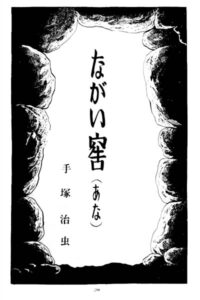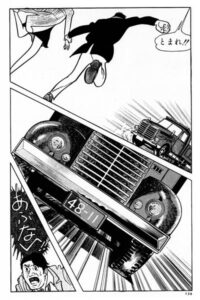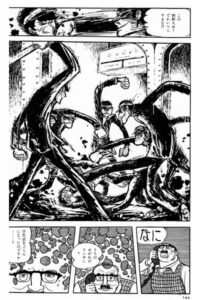Deep Cave (Manga)
Also known as ながい窟(あな)(Nagai Ana)
| English Title: | Deep Cave |
| In English? | No |
| Japanese Title: | ながい窟 (あな) Nagai Ana |
| Type: | Short Story |
| Original run: | 1970/11/06 |
| Published in: | Manichi Shimbun 毎日新聞社 |
| Published by: | Manichi Shimbun |
| Volumes: | None (Semi-sealed) |
The manga short-story Deep Cave (1970) was originally published on November 6, 1970 in the ‘Sunday Daily Supplementary Issue’ of Manichi Shimbun (毎日新聞社).
What it’s about
One night, after a round of drinking with his colleagues, Mr. Shohei Moriyama, Senior Managing Director of Nagahama Light Metal, runs into Mun-Jin Kim, a Korean resident of Japan and an old friend of his. Although he goes by the name Moriyama, Shohei is in fact also a Korean resident whose real name is Cho.
Based on their friendship forged as forced labourers in wartime Japan, Kim asks Moriyama for a favour – hiding an illegal immigrant from North Korea. Despite not wishing to get involved, Moriyama has little choice when a young man named Young-Jin Jo shows up unannounced on his doorstep. Fearing that an investigation will expose his own secret ethnicity – and do grave injury to his high social status in the process – Moriyama shelters Young-Jin.
Despite his broken Japanese and status as an illegal alien, Young-Jin’s tale of escaping Omura Prison four times in his desperate search for his long-lost mother captures the heart and mind of Moriyama’s daughter, Asako (aka Asa). Unashamed of her own Korean ethnicity, Asa enlists the help of her university classmates in tracking down Young-Jin’s mother. However, on the cusp of a tearful reunion, both Young-Jin and Asa are hit by a truck and killed instantly.
So ashamed and fearful is Moriyama of having his secret exposed, that he denies the Asa is his daughter – instead claiming she was simply one of his daughter’s friends from school. This infuriates his son, Hisashi, who derides his father for being a coward and shunning their heritage. In defiance, Hisashi decides to embrace the Korean culture and attends a Korean high school in Tokyo.
However, it seems not everyone has put past prejudices behind them, and one day, while walking home from school, Hisashi and his friend are set upon by thugs from a neighbouring Japanese high school. When Moriyama pays a visit to the headmaster to complain, at first trying to once again distance himself from the events, he becomes so outraged at the headmaster’s own racist attitudes that he finally proclaims “I’m Korean! What’s wrong with that?!”
What you should know
Originally published on November 6, 1970 in the ‘Sunday Daily Supplementary Issue’ of Manichi Shimbun, Deep Cave (1970) is another of Tezuka’s “social commentary” short stories that ran outside of the traditional manga publications. This allowed Tezuka the freedom to take on touchier subjects, such as the racism and prejudice faced by Japanese residents of Korean origin.
Given Imperial Japan’s annexation of the Korean peninsula (what is now both North and South Korea), and the migration of people (sometimes by force) during the period of 1910 to 1945, the relationship between the three countries is a complex one. Although a multifaceted issue, many Japanese residents of Korean origin still face issues of prejudice related to them not being “real Japanese” despite having been born and raised in Japan – sometimes tracing back even two or three generations.
Although Tezuka should be praised for raising general awareness of the issue, his treatment of racism is often considered a bit tone-deaf by readers with more modern sensibilities. As is the case in his short story dealing with racism against African-Americans in ‘Joe’s Visitor’ (1968) – collected as part of Under the Air (1968-70) – where the stereotypical caricatures undermine the message, similar issues crop up in Deep Cave (1970). For example, despite extolling the virtues of the Korean people, Mun-Jin Kim is depicted as the owner of a disreputable brothel.
For this reason, Deep Cave (1970) is considered one of Tezuka’s semi-sealed works – likely at his own request – and has only appeared once after its initial publication.
What else you should know
As a semi-sealed story ‘Deep Cave’ (1970) was not included in the Osamu Tezuka Complete Manga Works editions. However, given it’s lone re-print appearance it may be considered associated with the anthology title Under the Air.
Where you can get it
Good luck! The only two places ‘Deep Cave’ (1970) has ever been published is in the November 6, 1970 ‘Sunday Daily Supplementary Issue’ of Manichi Shimbun (毎日新聞社) and in the second volume of the first edition of Under the Air (1968-70), published by Sun Million Comics in 1972. Both editions are long out of print.
Stars Spotted:
- Osamu Tezuka makes a brief cameo when Young-Jin and Asa accidentally pay a visit to Mushi Productions.





